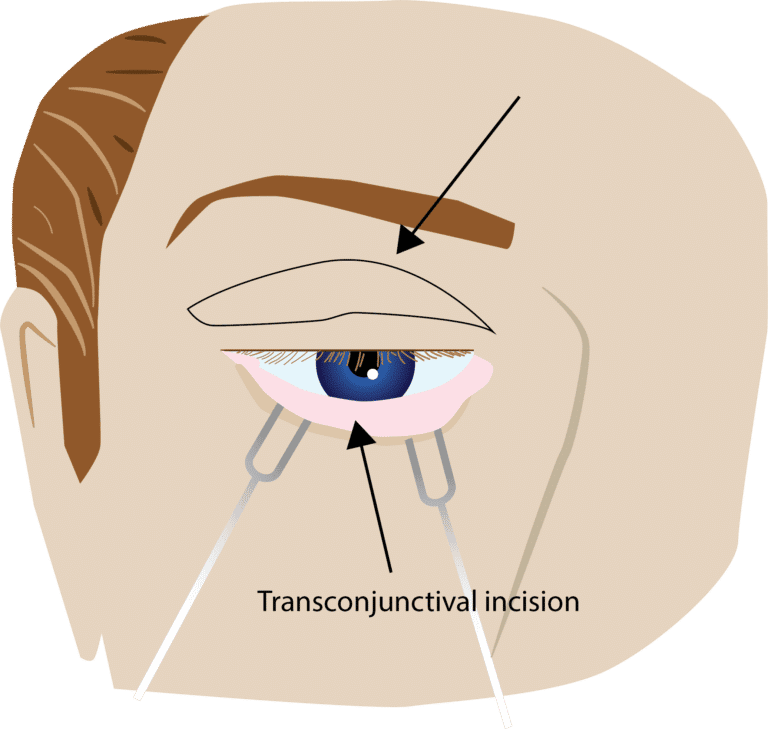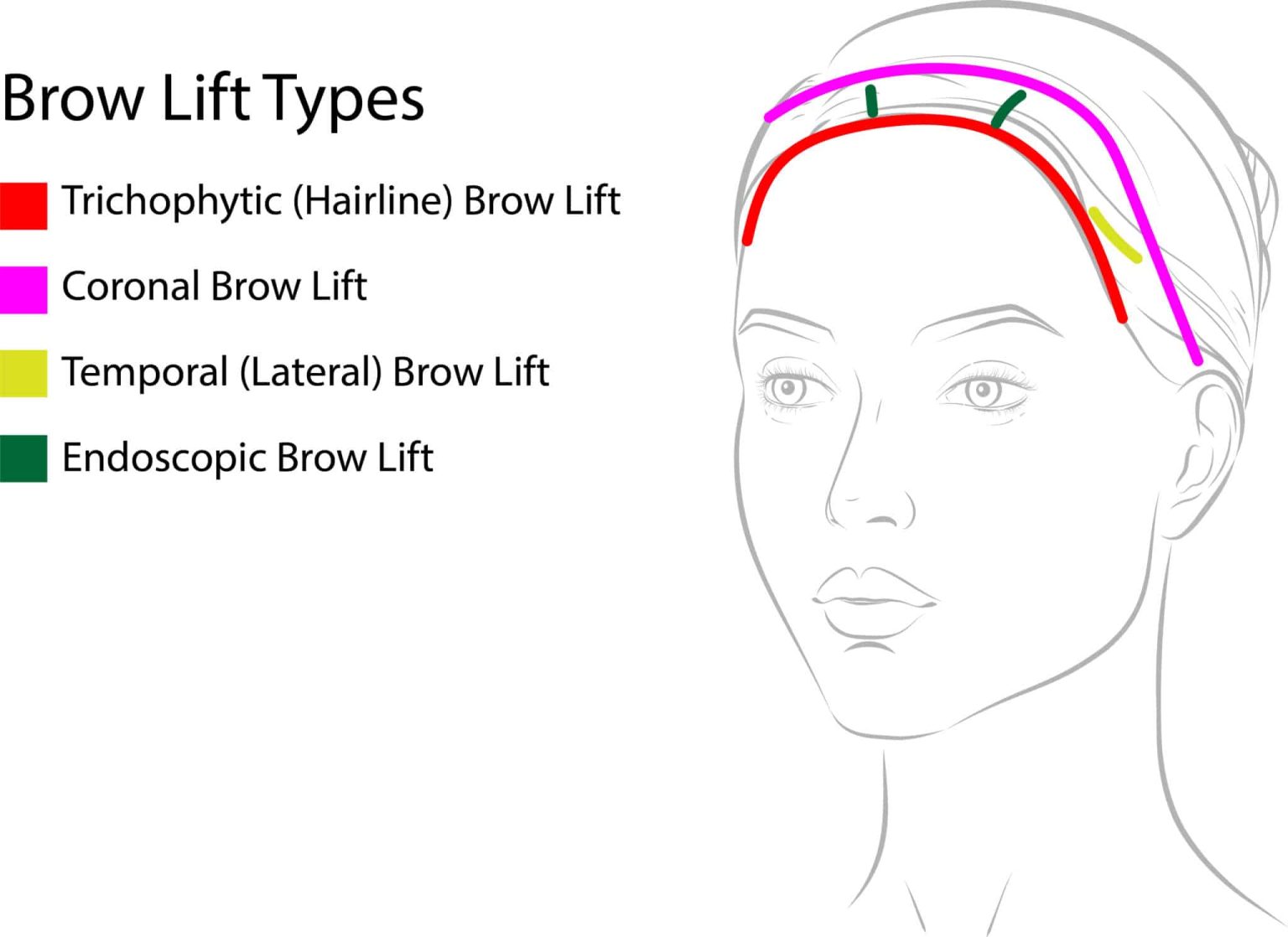Eyelid Surgery
The eyes are said to be the window into the soul. They are the central focus of any social interaction and play a critical role in facial expression and emotion. As we age, our eyes undergo various changes. Bone resorption, fat atrophy and loss of skin elasticity all contribute to the appearance of an aged eyelid. Many patients describe looking tired, sad or even angry all the time as a result of these changes.
Blepharoplasty, also referred to as eyelid surgery, aims to treat excessive or redundant eyelid skin, bulging or puffy appearing eyelids, hooded eyelids and wrinkles. It can be performed on the upper eyelids, lower eyelids or both.
Upper Blepharoplasty
Upper blepharoplasty primarily aims to tighten the upper eyelid skin by removing excess tissue and reducing the amount of “hooding.” This results in a rejuvenated, more alert appearance. Sometimes, the amount of redundant skin and hooding can obstruct one’s vision, in which case blepharoplasty can be a medical necessity. Other times, brow descent can exacerbate upper eyelid skin excess and hooding. If this is the case, a brow lift in conjunction with upper blepharoplasty would be the best approach.
Upper blepharoplasty begins by making an incision in the natural eyelid crease, which results in an incision that is imperceptible once healed. Excess skin above the incision is excised along with judicious removal of prolapsed fat. Careful attention is placed to ensure that the fat pads are not over-resected, resulting in a sculpted or hollowed appearance. If necessary, the remaining tissue is tightened, and the incision is sutured close.

Lower Blepharoplasty
Lower blepharoplasty can address under eye bags, bulging fat pads, extra skin and lower eyelid hollowing. There are various techniques, and our doctors will tailor this procedure to your specific needs.

Typically, an incision is made on the inner surface of your eyelid (transconjunctival approach) to gain access to the underlying fat pads. These fat pads can either be excised or repositioned to restore a smooth, youthful lower eyelid. If there is excess skin, a “skin pinch” excision can be performed just under the lash line to hide the resulting incision.
Sometimes, additional procedures are necessary to optimize results. These can include fat transfer or laser resurfacing, which address volume loss/hollowing and wrinkles, respectively.


Recovery
Following their procedure, patients can go home the same day. We recommend someone stay with you for the first 24 hours and can arrange for a home nursing service if desired. We see all patients the day after surgery to examine the healing process, clean any incisions, go over wound care and answer questions. If sutures were placed, the patient will return in one week for suture removal.
Bruising and swelling around the eyes are common following blepharoplasty. These symptoms gradually improve with time and are mostly resolved in 1-2 weeks. Cold compresses can help hasten their resolution. Residual bruising can be camouflaged with makeup or glasses at this time. Some patients experience dry or irritated eyes after their blepharoplasty. This also is transient and can be relieved with lubricating eye drops.
Most patients do not experience significant pain following the procedure. Pain medication is prescribed for pain relief, but most patients can wean themselves off in one or two days, taking Tylenol only as needed. Severe pain or visual changes should be reported to the office immediately.
FAQ
Am I a candidate for blepharoplasty?
Determining which patients are best suited for the procedure is essential for a successful outcome. Not everyone is a candidate for blepharoplasty while some patients benefit from blepharoplasty alone and others require additional procedures for optimal results. An in-person consultation and examination will be able to determine what is right for you. Whether it is excess skin, tired-appearing eyes, bulging fat pads or volume loss, our doctors will tailor his treatment plan accordingly.
What should I expect for my consultation?
Our facial plastic surgeons believe in providing a private, comfortable, honest environment to discuss each patient’s goals. We allot ample time for each consultation to not only address all patient concerns, but also to develop a strong rapport with each patient. We believe the keys to successful facial plastic surgery are natural, long-lasting results coupled with a strong relationship between patient, surgeon and the rest of the staff.
At the beginning of your consultation, you will meet with a member of our staff who will tell you a little about our practice and what to expect going forward. They will also obtain your medical history, which our doctors will review so they can customize his treatment accordingly. We will then listen to your concerns and discuss various treatment options with you in detail. We are committed to providing you with all the information necessary for you to understand and make an informed decision about your treatment. At the conclusion of your consultation, you will be provided with a quote for the procedures or treatments discussed and you will have the opportunity to schedule if desired.
We know that questions arise after your consultation. We are happy to answer your questions via phone or e-mail and our doctors are happy to see patients as often as necessary in follow-up/second consultation.
Where do you perform your blepharoplasty procedures?
Upper blepharoplasty can be performed safely in the office under local anesthesia with oral sedation if desired. Lower eyelid blepharoplasty is best performed with IV sedation to maximize comfort and is typically performed in an outpatient facility. Each procedure takes approximately 45 minutes to one hour to perform. General anesthesia is not required for either procedure.
How much time off do I need for work, exercise, life, etc.?
While each patient heals a little differently, most patients are social around one week post-operatively. You can resume work during this time, or earlier if desired if your job does not require physical labor. At one week, you may also use makeup to cover any residual bruising. We recommend avoiding exercise and strenuous activity for at least two weeks. At two weeks, light, minimal impact activity may resume and at three weeks you have no limitations.
Brow Lifts
Low lying eyebrows and forehead wrinkles can make someone appear tired, older or even angry. As we age, our brow descends as a result of increased tissue laxity, loss of collagen/elastin, downward pull from gravitational forces and bony remodeling of the orbit. A brow lift, also known as a forehead lift, specifically addresses these concerns. Restoring the brow into its natural, aesthetically balanced position can transform a patient’s tired, worn-out appearance into a natural, more youthful one. A brow lift is often performed in conjunction with an upper blepharoplasty to give the most dramatic improvement of the upper eyelid and brow subunit.
There are many ways to perform a brow lift and our doctors take an individualized approach with each patient. We take great care to rejuvenate the brow and forehead without creating a “surprised” or “shocked” appearance. At your consultation, we will go over the various approaches: coronal, trichophytic (hairline incision), endoscopic and mid forehead – and discuss the indications, pros and cons for each. When appropriate, we will favor the endoscopic approach due to the smaller, easily concealed incisions. No matter which approach is chosen, patients can be assured that the utmost care is taken to achieve natural, long-lasting results while minimizing scarring.
Brow Lift Procedure
The brow lift, or forehead lift, is performed on an outpatient basis. Patients will receive anesthesia, which typically consists of local anesthetic and “twilight” or IV sedation. There is no general anesthesia involved and patients do not need to be intubated.
Once the patient is comfortable, we will make a few short incisions in areas that can be easily concealed to access the tissues of the forehead and brow. The tissue is then released from its underlying attachment to the bone with specialized instruments. This allows for the elevation of the brow and forehead to occur. After the elevation is complete, the incisions are closed, and a dressing is applied.



Recovery
Following their procedure, patients are able to go home the same day. We recommend someone be with the patient at least the first night. There will be a dressing in place which is to remain on overnight. Every patient is seen in the office the following day to remove the dressing, clean the incisions and review wound care. The patient returns for suture removal one week later.
Most patients do not experience significant pain. A mild headache and nausea are not uncommon. Pain medication is prescribed for pain relief as needed.
FAQ
How is a brow lift performed?
Our facial plastic surgeons are comfortable and experienced in all types of brow lift techniques. They favor the endoscopic approach, which includes five small incisions hidden behind the hairline. There is often less swelling and recovery time compared with traditional approaches.
For those patients who are not a candidate for an endoscopic brow lift, the traditional coronal brow lift is an option. This typically involves an incision behind the hairline that extends from one ear to the other. The tissue is elevated off the underlying bone similar to an endoscopic brow lift and is secured in position. It provides excellent exposure but can elevate the patient’s hairline. It is not ideal for patients with a high hairline to begin with.
The trichophytic, or hairline brow lift, is an excellent option for patients with a high hairline where any elevation would further recede their hairline and give an unnatural appearance. An irregular incision is made along the natural hairline to minimize the appearance of any scarring. The forehead and brow are then able to be elevated in a similar fashion to the coronal brow lift.
Finally, for those patients who wear their hair short and have deep wrinkles on their forehead, a mid-forehead brow lift may be an option. With any of these techniques, meticulous attention is paid to incision placement, wound closure and scar camouflage.
Are there alternatives to surgery to raise my brow?
While surgery provides the most significant, long-lasting results for brow and forehead rejuvenation, there are other non-invasive treatments available that can help. One option is the neuromodulators Botox® and Xeomin®. The use of these products is sometimes referred to as the “chemical brow lift” or “non-surgical brow lift.” Both treatments work by blocking the nerve signals that cause muscle contraction. By blocking the muscles responsible for depressing our brow, patients can achieve some elevation of the brow in addition to smoothing the lines and wrinkles of the forehead. The results are only temporary and are an excellent option for patients considering surgery or those who want a simple non-invasive solution to rejuvenate the forehead and brow.
What should I expect for my consultation?
Our doctors believe in providing a private, comfortable, honest environment to discuss each patient’s goals. We allot ample time for each consultation to not only address all patient concerns, but also to develop a strong rapport with each patient. We believe the keys to successful facial plastic surgery are natural, long-lasting results coupled with a strong relationship between patient, surgeon and the rest of the staff.
At the beginning of your consultation, you will meet with a member of our staff who will tell you a little about our practice and what to expect going forward. They will also obtain your medical history, which our doctors will review so they can customize their treatment accordingly. We will then listen to your concerns and discuss various treatment options with you in detail. We are committed to providing you with all the information necessary for you to understand and make an informed decision about your treatment. At the conclusion of your consultation, you will be provided with a quote for the procedures or treatments discussed and you will have the opportunity to schedule if desired.
We know that questions arise after your consultation. We are happy to answer your questions via phone or e-mail and our doctors are happy to see patients as often as necessary in follow-up/second consultation.
How much time off do I need for work, exercise, life, etc.?
While each patient heals a little differently, most patients are social between around two weeks. Bruising and swelling are common in the early recovery period. You can resume work during this time, or earlier if desired if your job does not require physical labor. We recommend avoiding exercise and strenuous activity for at least two weeks. At two weeks, light, minimal impact activity may resume and at three weeks you have no limitations.
Call Advanced Aesthetics at (856) 500-3223 for more information or request an appointment today!